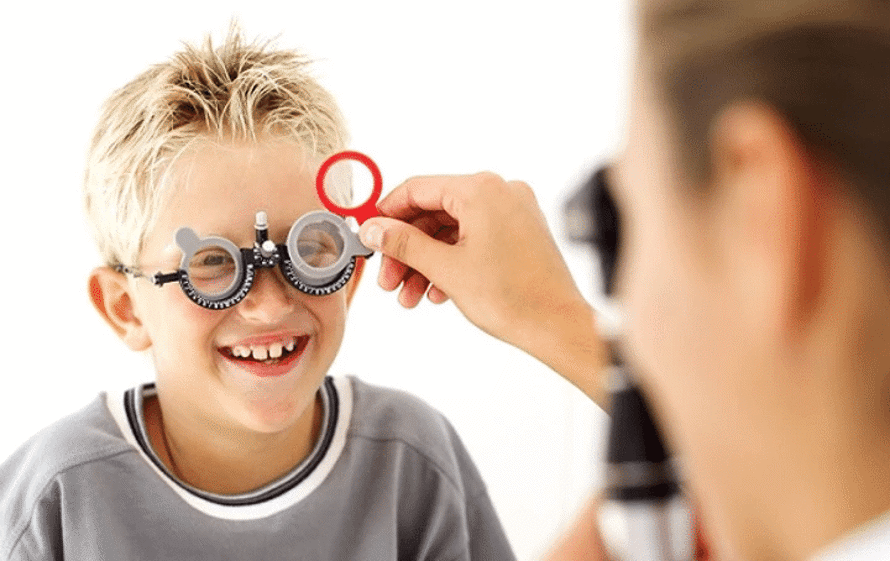Kid’s glasses: Top Tips for Buying Kids’ Glasses
Picking out a pair of glasses involves seeing how they fit, trying different styles and finding an option that suits your budget. But what about picking out glasses for your children?
Helping children find glasses that are comfortable, effective and allow them to feel relaxed and confident can be challenging. In this article, we’ll provide useful tips to help you find glasses for your kids that fit comfortably and closely, suit your child’s style and preference, and ensure that they get the best vision possible.

Understanding the Importance of Children's Eye Health
It’s important to remember that as well as being a fashionable accessory, glasses provide an important service that affects your child’s health and their ability to interact with the world.
First and foremost, the purpose of glasses is to correct vision and protect the eyes. For children, eye health is crucial to their education and development. Clear vision allows them to participate in academic activities and pastimes fully. Not only that but undiagnosed eye conditions and vision loss can cause long-term damage affecting eye health and well-being in the long run.
Finding glasses that fit properly doesn’t only save you another trip to the opticians, it helps to make sure that your child will keep wearing their glasses throughout the day supporting their eye health and well-being. The same is true for selecting the right lenses, caring for glasses correctly and even helping your child pick out their favourite style.
Signs that Your Child Might Need Glasses
Before we talk about the best way to pick out your child’s glasses, here are some tips for spotting that they may need them in the first place.
In some cases, your child may tell you they’re struggling to see, but often they won’t notice they are experiencing vision loss until it’s quite advanced. The following tips are behaviour-based, meaning you can spot them even if your child doesn’t complain of vision loss.
- Squinting, straining and eye-rubbing. When children struggle to see they may try to compensate by squinting; this can bring on eye strain and sore eyes often causing them to rub them frequently.
- Sitting close to screens or holding reading material too close. These are common examples but you could notice it with any objects.
- Head tilting or covering one eye. This is another way children try to manually focus on an object when their vision is impaired.
- This is another common symptom of eye strain brought on by impaired vision.
- Academic difficulties. There are many reasons a child may be struggling in school, but a problem with their vision is one common cause.
Some children will not like the idea of getting glasses, but if you stay positive and enthusiastic they’ll have a much easier time coming to terms with their new eyewear.
Scheduling an Eye test
Whether you suspect your child may need glasses or it’s a routine exam, it’s important to stay on top of scheduling your eye tests. Children should have an eye test at least once a year and it’s never too early to start.
If you have an optometrist who provides a good family service, it is simpler and more convenient to stick with them. If you need to look for a new optometrist explore your options carefully – look for practices that offer comprehensive eye exams and have special services and expertise when it comes to children’s eye care and eyewear.

Factors to Consider When Buying Glasses for Children
You’ve learned your child needs vision correction and chosen glasses over contact lenses – what next?
There are a few factors to consider when buying your child their first pair of glasses. We’ll explore some of these in more detail later on, but these are some basic things to consider.
- Where to buy your child’s glasses. Most prescription glasses are purchased at opticians with a few exceptions. Buying glasses from a professional is the best way to ensure they are correct for your child. Look for practices with qualified dispensing opticians, who can help you find custom glasses to meet your child’s needs.
- Of course, finding glasses that fit your budget is important. Doing research beforehand can help you to get a good deal on glasses and making your decision carefully will mean you don’t have to alter the glasses or get new ones.
- Fit, comfort and durability. Children need to feel comfortable in their glasses and they need to stay on! Finding frames that are made of strong, flexible materials that fit easily and don’t slip is an important consideration.
- There are many different kinds of lenses with different coatings. Explaining your priorities to a dispensing optician will help them to recommend lenses that are right for you.
Frame Materials: Choosing Durable and Safe Glasses for Kids
We’ve said that children’s glasses should be comfortable and durable but which materials are best at providing this?
Frames are made from many different materials, almost all of which can make a quality pair of glasses. However, there are a few types that generally provide robust, lightweight frames for greater comfort and durability.
Flexible plastics are a common choice. They can survive a good amount of wear and tear, tend not to break or snap and because they are lightweight are usually comfortable. Acetate and Nylon are both good options.
Metal frames are very strong and can withstand even the most adventurous children. Some materials like titanium and stainless steel are not flexible and need to retain their shape (Morgan, 2020). Other like flexon and beryllium can be bent and then returned to their original shape (Morgan, 2020). Metal glasses are generally comfortable but not in every case, so it’s important to let your child get a good sense of how they feel.
Some glasses are made of natural materials like wood. While these options are becoming better at providing durability, many can break quite easily and for children are often not the best choice.
Frame Styles and Designs: Finding Frames Your Child Will Love
Finding the right style of frames isn’t about making the most fashionable choice – for children especially, it’s about giving them eyewear that allows them to feel relaxed and comfortable while expressing their unique personalities.
Many independent opticians will offer eyewear styling which makes life a lot easier. They use expert knowledge about face shape and style to help match frames to each individual.
The main frame styles and shapes are rectangular, oval, round, square, aviator, rimless, browline and cateye. These days there are many more options to choose from, but these are the most common you’ll encounter.
Choosing the right one is partially about personal preferences – it’s always a good idea to give your child plenty of time to try on glasses and see how they feel in them.
Nevertheless, there are general principles that can help you narrow down the list. For example, glasses should usually contrast and complement face shape. This is why people with rounder faces tend to look better in squarer frames, while people with a square face shape often prefer rounder frames.
Size and Fit Considerations: Ensuring Comfort and Proper Vision
Most opticians will help you to find the right fit for your child, but it helps to know what makes a pair of glasses fit so you can be sure they get to enjoy comfortable wear.
The first thing to consider is how the glasses fit on their nose. Ill-fitting glasses can sit uncomfortably, slip off the nose or pinch the skin. Whether the glasses have an adjustable bridge or not, you should check that they fit comfortably without slipping or leaving red marks on the skin.
The frames should be of a width that more or less matches the width of the wearer’s face. Similarly, the arms of the glasses should sit comfortably behind the ears rather than going too far or falling short.
Lens size is also important. Lenses affect not only the style but also the field of vision that glasses provide. Going for a lens that is too narrow can make it difficult to see during activities like reading or playing sports.
For growing children, it can be tempting to get glasses that are too large. While there’s nothing wrong with allowing a bit of room for them to grow into the glasses, choosing a size that is too big for them will likely cause problems.

Lens Types and Prescription Requirements: Understanding the Basics
Having a basic understanding of the different types of prescription lenses can help you navigate the selection process and make sure you end up with the right glasses.
Lens types depend on the type of vision loss they need to correct – for example, people who are longsighted, shortsighted or both. Single-vision lenses are for people who struggle to see at one distance, while bifocal and progressive lenses can correct multiple types of vision loss. Bifocal lenses divide the lens in two so the eye can switch focus between different distances, while progressive lenses gradually transition between the two prescriptions.
Prescription lenses can also be treated with a variety of coatings including anti-scratch, anti-glare and UV-protected options.
Your child’s prescription should always be calculated by a qualified optometrist. They may also recommend specialised lenses if your child has an eye condition or a more complex prescription.
Safety Features and Considerations: Protecting Your Child's Eyes
Eyewear for children not only corrects their vision but can protect their eyes as well. Considering how their frames and lenses may improve their eye health can help you get the most out of their glasses.
Today, lenses are designed to be durable and not to break in a way that is dangerous to the users. Some glass lenses, however, can still shatter so it is important to pick an impact-resistant or ‘shatterproof’ option. If your child is especially active or sporting, special lenses and frames could help protect their eyes from debris and stop them from breaking.
Ultra-violet (UV) light can damage children’s eyes over time. Choosing lenses with UV protection can limit this effect and protect them from eye conditions and vision loss in the future.
Other coatings can limit the amount of blue light that enters the eyes when using screens. Increasingly, parents are concerned that children’s use of screen time will damage their eyes. While it is true that screen time is strongly linked to eye strain, there is little evidence that blue light is the main culprit. As such, blue light coatings may help your child, but for screen time it is better to recommend regular breaks, eye exercises and hydration.
Caring for Children's Glasses
After you’ve found a pair of glasses your child loves, the next step is to help them look after their eyewear. Here are some tips on maintaining and cleaning glasses that you can encourage your child to make a habit of.
- To make the most out of glasses they need to be clean. Every glasses wearer should be equipped with a microfibre cloth. Children will be especially tempted to clean their glasses with anything they have handy, but this will cause scratches that can permanently damage the lens and coating. Using the microfibre cloth after a gentle rinse will provide a clear, smudge-free lens.
- Children tend to leave their glasses anywhere and everywhere. Providing them with a convenient and easy-to-carry case can go a long way towards helping them protect their eyewear from damage.
- Quality glasses require minimal maintenance, but over time minor adjustments may be necessary to ensure they continue to fit correctly. These should always be carried out by a professional to ensure they stay in top condition.
Conclusion
Getting your children a new pair of glasses may seem like a minefield, but we hope this article has given you some helpful tips on how to navigate it.
Being proactive and enthusiastic about correcting your child’s vision can help them to feel comfortable and confident about their glasses. Eyewear for children can be a fun and exciting way for them to express their personality and take care of their health.
Related articles





